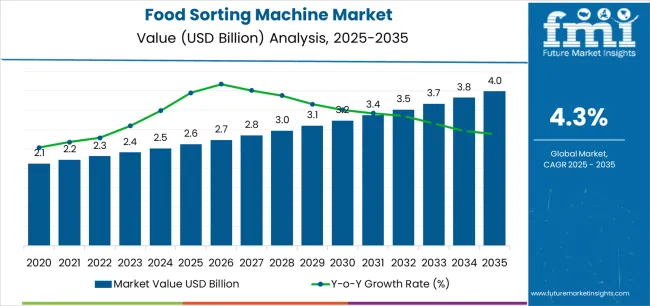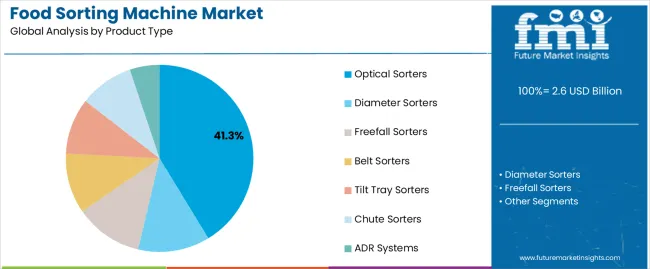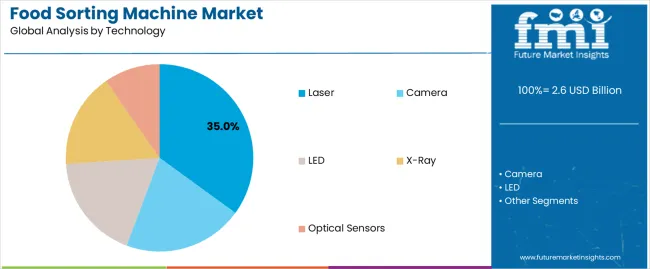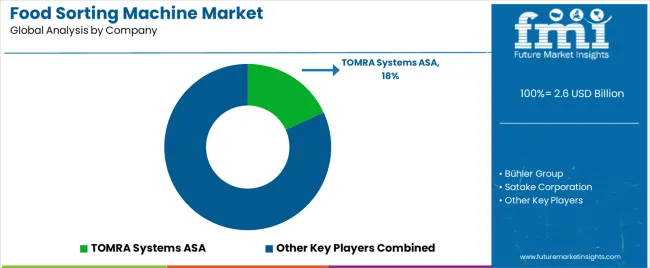The Food Sorting Machine Market is estimated to be valued at USD 2.6 billion in 2025 and is projected to reach USD 4.0 billion by 2035, registering a compound annual growth rate (CAGR) of 4.3% over the forecast period.
The Food Sorting Machine Market is experiencing steady expansion due to the rising demand for automation in food processing and packaging industries. Growing concerns about food safety, quality control, and compliance with stringent regulatory standards are accelerating adoption of advanced sorting technologies. The rising focus on operational efficiency and minimizing food waste is further contributing to the increased use of food sorting machines across multiple applications.
The integration of artificial intelligence and machine vision has enhanced accuracy and speed, enabling processors to ensure consistency in product quality. Additionally, rapid growth of packaged and processed food demand, driven by changing consumer lifestyles and increasing urbanization, is providing strong growth momentum.
Food companies are increasingly investing in automated sorting solutions to reduce labor dependency and improve production throughput The future outlook for the market is promising, with continued technological advancements, rising awareness of sustainable food practices, and growing investment in modern food processing facilities across both developed and emerging economies.

| Metric | Value |
|---|---|
| Food Sorting Machine Market Estimated Value in (2025 E) | USD 2.6 billion |
| Food Sorting Machine Market Forecast Value in (2035 F) | USD 4.0 billion |
| Forecast CAGR (2025 to 2035) | 4.3% |
The market is segmented by Product Type, Technology, and End-Use Industry and region. By Product Type, the market is divided into Optical Sorters, Diameter Sorters, Freefall Sorters, Belt Sorters, Tilt Tray Sorters, Chute Sorters, and ADR Systems. In terms of Technology, the market is classified into Laser, Camera, LED, X-Ray, and Optical Sensors. Based on End-Use Industry, the market is segmented into Dry Food And Packaged Food Processing, Fruits And Vegetable Processing, Dairy Product Sorting, Fats And Oil Processing, Fish/Seafood Sorting, and Meat Processing. Regionally, the market is classified into North America, Latin America, Western Europe, Eastern Europe, Balkan & Baltic Countries, Russia & Belarus, Central Asia, East Asia, South Asia & Pacific, and the Middle East & Africa.

The optical sorters segment is projected to hold 41.30% of the Food Sorting Machine Market revenue share in 2025, making it the leading product type. The strong performance of this segment is driven by its ability to deliver high levels of accuracy and efficiency in sorting operations, enabling food processors to achieve superior quality control.
Optical sorters are designed to detect and remove defective items, contaminants, and foreign materials with precision, ensuring food safety standards are met consistently. The use of advanced camera systems and machine vision technology in optical sorters has further enhanced their performance, making them highly reliable for large-scale food processing operations.
The growing demand for processed and packaged foods has increased reliance on automated systems, where optical sorters play a vital role in reducing waste and improving overall yield Their flexibility across multiple food categories and compatibility with diverse production environments have positioned optical sorters as a dominant product type within the market.

The laser technology segment is expected to account for 35.00% of the Food Sorting Machine Market revenue share in 2025, establishing it as a leading technology type. The segment’s growth has been supported by the ability of laser-based systems to detect defects and impurities based on structure, moisture, and chemical composition. Unlike conventional methods, laser technology ensures superior precision in identifying even the smallest contaminants, which is critical in maintaining food quality and safety.
Adoption of laser systems has been driven by food processors seeking advanced solutions to comply with strict regulatory requirements and consumer expectations. The efficiency and speed of laser technology also enable higher throughput, making it suitable for large-scale operations.
Increasing investment in modernizing food processing facilities has further propelled demand for laser-based sorting systems Their ability to reduce human error, minimize product loss, and optimize quality assurance processes continues to strengthen their role as a vital technology in the food sorting machine market.

The dry food and packaged food processing segment is anticipated to capture 32.90% of the Food Sorting Machine Market revenue in 2025, underscoring its leadership among end-use industries. The rising demand for packaged and ready-to-eat products has fueled the adoption of automated sorting systems to ensure product quality and safety. Growing consumer preference for convenience foods and increasing retail penetration of packaged goods have elevated the need for efficient sorting solutions in this segment.
Automated sorting machines are widely used to detect contamination, improve consistency, and maintain compliance with international food safety standards, which are essential in packaged food production. Additionally, the ability of these machines to reduce operational costs and minimize food wastage has made them a preferred choice among food processors.
The rapid pace of urbanization and evolving dietary patterns have further contributed to demand growth in this segment With continuous innovations in sorting technologies, the dry food and packaged food processing industry is expected to remain a dominant contributor to overall market revenue.
The table below presents a comparative assessment of the variations in CAGRs over six months for the base year (2025) and current year (2025) for the industry. This analysis reveals vital shifts in performance and indicates revenue realization patterns, thereby providing stakeholders with a better vision of the growth trajectory over the year.
The first half of the year, or H1, spans from January to June. The second half, H2, includes the months from July to December. In the first half (H1) from 2025 to 2035, the industry is predicted to surge at a CAGR of 4.1%, followed by a slightly higher growth rate of 4.5% in the second half (H2).
| Particular | Value CAGR |
|---|---|
| H1 | 4.1% (2025 to 2035) |
| H2 | 4.5% (2025 to 2035) |
| H1 | 4.2% (2025 to 2035) |
| H2 | 4.7% (2025 to 2035) |
Moving into the subsequent period, from H1 2025 to H2 2035, the CAGR is projected to decline slightly to 4.2% in the first half and remain relatively considerable at 4.7% in the second half.
Adoption in the Food Industry to Surge for Food Processing Applications
The food industry is experiencing a surge in the use of advanced food sorting machines due to the growing demand for efficient food processing and quick delivery. The industry is expected to rise significantly due to the high importance of these machines in streamlining production processes and ensuring product quality.
Food producers increasingly utilize cutting-edge sorting technology to meet customer demands for speed and convenience while maintaining strict quality standards.
In the United States, the food and beverage industry is booming. Packaged food and drinks were estimated to be worth over USD 1 trillion in 2025. With the industry's growth projected to continue, manufacturers are adopting automation technologies to keep up with the rising demand while maintaining high safety and quality standards.
Stringent Government Regulations Compel Manufacturers to Adopt Unique Sorting Technologies
Strict government regulations for food safety serve as a significant driver propelling the sorting equipment market. With rising concerns regarding foodborne illnesses and contamination, regulatory bodies worldwide impose strict standards on food processing and packaging.
For instance, in the European Union (EU), regulations such as the Food Safety Modernization Act (FSMA) and Hazard Analysis and Critical Control Points (HACCP) mandate rigorous safety measures throughout the food supply chain. In response to these regulations, food manufacturers and processors are increasingly investing in unique sorting equipment to ensure compliance and mitigate risks.
Sorting technologies like optical sorting and X-ray inspection systems improve food safety and quality assurance by detecting contaminants and removing defective products. As regulatory requirements evolve, demand for innovative sorting solutions remains strong, driving growth and promoting a safer food environment.
Rising Demand for Processed and Packaged Foods Fuels Adoption
Urbanization and hectic lifestyles are driving demand for convenient, ready-to-eat food options. This demand necessitates efficient sorting equipment to maintain food quality and safety standards. Innovative sorting technologies are gaining traction in the food processing industry, ensuring precise sorting based on size, shape, and quality, while removing contaminants and defects, and enhancing product integrity.
Consumers prioritize convenience and hygiene in food choices, making sophisticated sorting equipment essential for food processors to maintain competitiveness and meet regulatory requirements. This trend underscores the pivotal role of advanced sorting equipment in supporting the growth and evolution of the processed and packaged food industry.
SMEs Find it Difficult to Adopt Sorting Machines due to High Initial Expenditure
The market is limited by high initial capital expenditure, particularly for small and medium-sized enterprises (SMEs). The costs of purchasing, setting up, and incorporating sorting machinery are prohibitive, making it difficult for SMEs to justify the investment. The need for additional expenditures on training, maintenance, and operational costs further exacerbates the financial burden.
The complexity of cutting-edge systems, such as AI and robotics, presents significant restraints for adoption. Businesses face challenges in sourcing personnel with the necessary expertise to operate and troubleshoot these systems.
Furthermore, training employees for efficient and safe use of these machines demands significant time and resources. Shortage of skilled personnel and high training costs further hinder the widespread adoption of food sorting machines, hindering growth.
The food sorting machine industry grew at a CAGR of 1.9% from 2020 and 2025. The industry reached USD 2,415.4 million in 2025. From 2020 to 2025, the market experienced significant growth and transformation due to increasing demand for efficiency in food processing and concerns over food safety and quality.
Traditional optical sorting machines have been augmented with advanced sensors, AI-powered algorithms, and machine learning capabilities, thereby improving sorting accuracy, speed, and efficiency. The industry has expanded rapidly, with developing regions like Asia Pacific and Latin America experiencing robust growth due to changing dietary habits and investments in food processing infrastructure.
Established markets in North America and Europe have also seen steady growth due to stringent regulatory standards and surging adoption of automated solutions.
Food processors are increasingly investing in cutting-edge sorting technologies to comply with regulatory standards and meet consumer expectations for safe and high-quality food products. This trend has LED to the growing adoption of hygienic and high-performance sorting machines capable of handling a wide range of food products.
The market has seen consolidation through mergers and acquisitions, with key companies broadening their product portfolios and geographic presence. The industry is poised for continued growth, mainly driven by increasing automation in food processing and rising consumer demand for food safety. The industry is expected to rise at a steady CAGR of 4.5% in terms of value during the forecast period, reaching USD 3,887.6 million by 2035.
Tier 1 segment comprises companies with revenue of above USD 80 million, capturing a significant share of 20% to 25% in the market. These frontrunners are characterized by high production capacity and a wide product portfolio.
They are distinguished by extensive expertise in manufacturing and a broad geographical reach, underpinned by a robust consumer base. Prominent companies within Tier 1 include TOMRA Systems ASA, Bühler Group, NPI Sorters (Duravant), Satake Corporation, and others.
Tier 2 companies include mid-sized firms with revenue of USD 30 to 80 million, having a presence in specific regions. These companies are highly influencing the local market. Prominent companies in Tier 2 are Raytec Vision (ATS Corporation), Sesotec GmbH, EUROSORT, Pellenc ST, and STEINERT GmbH. These companies are projected to account for 35 to 40% of the industry.
Tier 3 includes most of the small-scale companies operating at the local level and serving niche markets, with revenue below USD 30 million. These companies are notably focused on meeting local demand and are hence categorized within the Tier 3 segment. They are small-scale participants with limited geographical reach. Tier 3 players such as Optimum Sorting, CIMBRIA, and others are projected to account for 30 to 35% of the industry.
The section provides a comprehensive analysis of the industry by county, highlighting trends, dynamics, opportunities, and challenges specific to each of them. It enables businesses to make informed decisions and develop tailored strategies for their respective industries.
India is expected to emerge as a dominating country in the industry during the forecast period with a projected CAGR of 5.6% through 2035. China, Spain, and Japan are anticipated to follow closely to become significant countries with projected CAGRs of 4.6%, 4.3%, and 5.1%, respectively.
| Countries | CAGR 2025 to 2035 |
|---|---|
| India | 5.6% |
| Japan | 5.1% |
| China | 4.6% |
| Spain | 4.3% |
| Mexico | 3.8% |
| Germany | 3.2% |
China's rapid urbanization and industrialization have LED to significant changes in consumer lifestyles, with a growing preference for processed and packaged foods. This shift drives demand for efficient food sorting machines to ensure product quality and safety, thereby boosting revenue.
The government of China has implemented stringent food safety regulations to address safety concerns and improve public health in the country. Food processors are being encouraged to invest in advanced sorting machines to comply with these regulations, which is projected to drive growth. Sales in the country are anticipated to soar at a CAGR of around 4.6% during the assessment period.
Over the assessment period, demand in the United States is set to rise at 3.1% CAGR. The country is experiencing a significant boom, augmented by a strong focus on efficiency and innovation.
As demand for processed and packaged foods rises, manufacturers are increasingly adopting advanced sorting technologies to maintain high standards of food quality and safety. Innovative technologies like AI and machine learning are revolutionizing sorting processes, thereby enhancing precision and speed. These technologies are helping companies to ensure the removal of contaminants and defects with high accuracy.
India is poised to exhibit a CAGR of 5.6% during the assessment period. The country is witnessing a remarkable surge in demand for food sorting machines, propelled by several key factors. As the population surges in the country, processed and packaged food consumption rises among individuals with hectic lifestyles, necessitating efficient sorting solutions to maintain quality and safety standards.
Government’s initiatives to promote food processing companies and improve supply chain infrastructure are further bolstering demand for sorting machines in India. With incentives and support programs in the country, a few firms are increasingly inclined to invest in advanced technologies that enhance efficiency and competitiveness.
The section below offers businesses valuable data and analysis on the two leading segments of the target industry, enabling them to understand the dynamics and invest in beneficial areas. Analyzing trends, opportunities, and challenges provides companies with a comprehensive understanding of growth, enabling them to make informed decisions in a complex business environment.
Based on product type, the optical sorter segment is dominating with a value share of 41.3% in 2025. Dry food and packaged food processing is emerging as the leading end-use industry with a value share of 32.9% in the same year.
| Segment | Optical Sorter (Product Type) |
|---|---|
| Value Share (2025) | 41.3% |
Innovations in optical sorting technology have enhanced efficiency, accuracy, and versatility, making these highly appealing to industries like food processing, agriculture, recycling, and pharmaceuticals. Stringent quality standards and regulations worldwide are augmenting the adoption of optical sorters to ensure product quality and safety across various industries.
Integration of optical sorters into existing production lines is facilitated by robust industrial infrastructure and high levels of automation. Sensor technology innovations are projected to help expand optical sorter applications across materials and operations.
A few companies are integrating machine learning (ML) algorithms for improved quality and adaptive smart decision-making. Over the forecast period, demand in the optical sorter segment is set to rise at a CAGR of 4.7%.
| Segment | Dry Food and Packaged Food Processing (End-use Industry) |
|---|---|
| Value Share (2025) | 32.9% |
The global trend toward convenience foods is boosting demand for packaged food products. With busy lifestyles, consumers are increasingly opting for ready-to-eat and easy-to-prepare food options.
Food processors are utilizing efficient sorting machines to meet the increasing demand for high-quality, safe food products. These machines are essential in detecting foreign materials and defective items in dry foods like grains, nuts, and seeds, ensuring food safety and product quality.
This is primarily driven by consumer expectations and stringent regulatory requirements. As per the analysis, the dry food and packaged food processing segment is projected to thrive at 3.4% CAGR during the forecast period.

The global food sorting machine industry is fragmented, with leading companies accounting for about 35% to 40% of the total share. TOMRA Systems ASA, Bühler Group, Sesotec GmbH, Satake Corporation., STEINERT GmbH., Raytec Vision (ATS Corporation), CIMBRIA, Pellenc ST, EUROSORT, and Optimum Sorting are the leading manufacturers and suppliers of food sorting equipment listed in the report.
Key food sorting equipment companies are investing in continuous research activities for introducing new products and increasing their manufacturing capacity to meet end-user demand. They are also showing an inclination toward adopting strategies, such as acquisitions, partnerships, mergers, and facility expansions to strengthen their global footprint.
Manufacturers are directed toward inorganic business techniques like acquisitions, mergers, and regional growth to gain more profit and a competitive edge. Leading companies are projected to collaborate with research institutes to accelerate innovation and create novel derivatives. Acquisitions and mergers would help manufacturers broaden their product portfolios and establish a strong presence.
Industry Updates
As per product types, the industry has been categorized into optical sorters, diameter sorters, freefall sorters, belt sorters, tilt tray sorters, chute sorters, and ADR systems.
Based on technology, the industry is split into laser, camera, LED, X-ray, and optical sensors.
In terms of end-use industries, the industry is segmented into dry food and packaged food processing, fruits and vegetable processing, dairy product sorting, fats and oil processing, fish/seafood sorting, and meat processing.
Industry analysis has been carried out in key countries of North America, Latin America, Western Europe, Eastern Europe, East Asia, South Asia, and the Middle East and Africa.
The global food sorting machine market is estimated to be valued at USD 2.6 billion in 2025.
The market size for the food sorting machine market is projected to reach USD 4.0 billion by 2035.
The food sorting machine market is expected to grow at a 4.3% CAGR between 2025 and 2035.
The key product types in food sorting machine market are optical sorters, diameter sorters, freefall sorters, belt sorters, tilt tray sorters, chute sorters and adr systems.
In terms of technology, laser segment to command 35.0% share in the food sorting machine market in 2025.






Full Research Suite comprises of:
Market outlook & trends analysis
Interviews & case studies
Strategic recommendations
Vendor profiles & capabilities analysis
5-year forecasts
8 regions and 60+ country-level data splits
Market segment data splits
12 months of continuous data updates
DELIVERED AS:
PDF EXCEL ONLINE
Food & Beverage OEE Software Market Size and Share Forecast Outlook 2025 to 2035
Food Grade Crosslinked Polyvinylpolypyrrolidone (PVPP) Market Size and Share Forecast Outlook 2025 to 2035
Food Grade Cassia Gum Powder Market Size and Share Forecast Outlook 2025 to 2035
Food Grade Dry Film Lubricant Market Size and Share Forecast Outlook 2025 to 2035
Foodservice Equipment Market Analysis - Size, Share, and Forecast Outlook 2025 to 2035
Food Basket Market Forecast and Outlook 2025 to 2035
Food Grade Tremella Polysaccharide Market Size and Share Forecast Outlook 2025 to 2035
Foodservice Paper Bag Market Size and Share Forecast Outlook 2025 to 2035
Food Stabilizers Market Size and Share Forecast Outlook 2025 to 2035
Food Packaging Film Market Size and Share Forecast Outlook 2025 to 2035
Food Certification Market Size and Share Forecast Outlook 2025 to 2035
Food Tray Market Size and Share Forecast Outlook 2025 to 2035
Food & Beverage Industrial Disinfection and Cleaning Market Size and Share Forecast Outlook 2025 to 2035
Food Technology Market Size and Share Forecast Outlook 2025 to 2035
Food Tourism Sector Market Size and Share Forecast Outlook 2025 to 2035
Food Processing Boiler Market Size and Share Forecast Outlook 2025 to 2035
Food Minerals Market Size and Share Forecast Outlook 2025 to 2035
Food And Beverage Chemicals Market Size and Share Forecast Outlook 2025 to 2035
Food and Beverage Industry Software Market Size and Share Forecast Outlook 2025 to 2035
Food Packaging Films Market Size and Share Forecast Outlook 2025 to 2035

Thank you!
You will receive an email from our Business Development Manager. Please be sure to check your SPAM/JUNK folder too.
Chat With
MaRIA